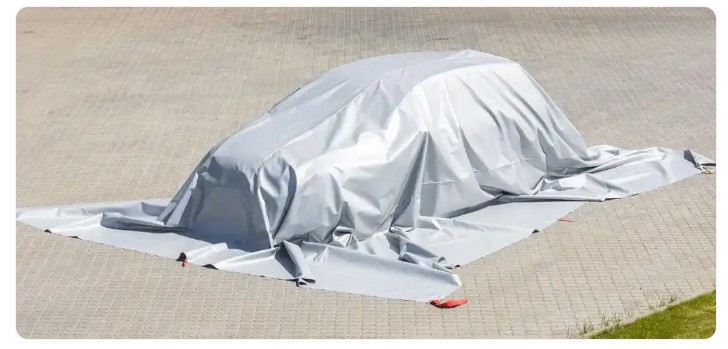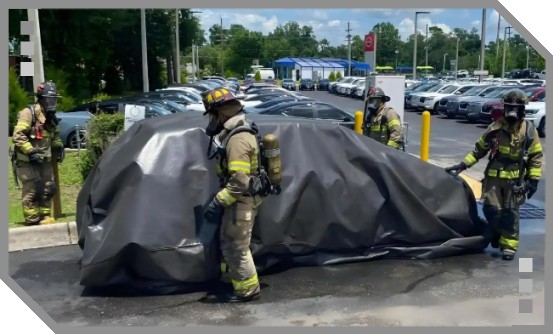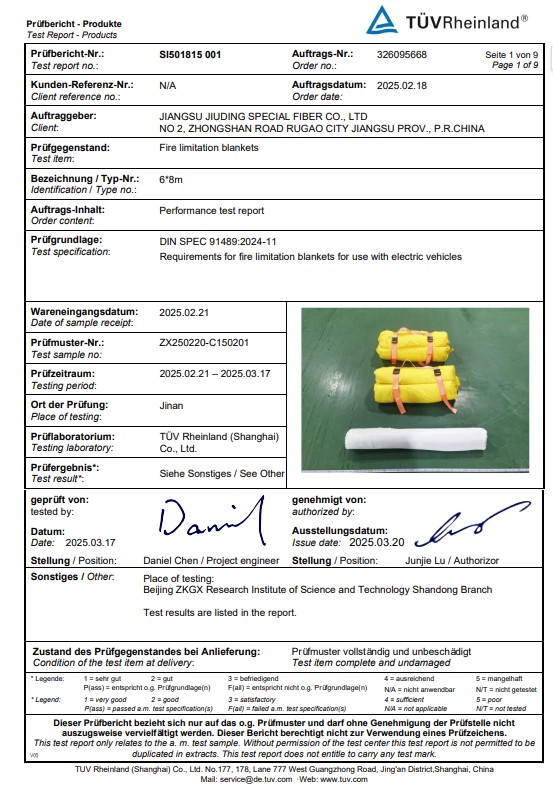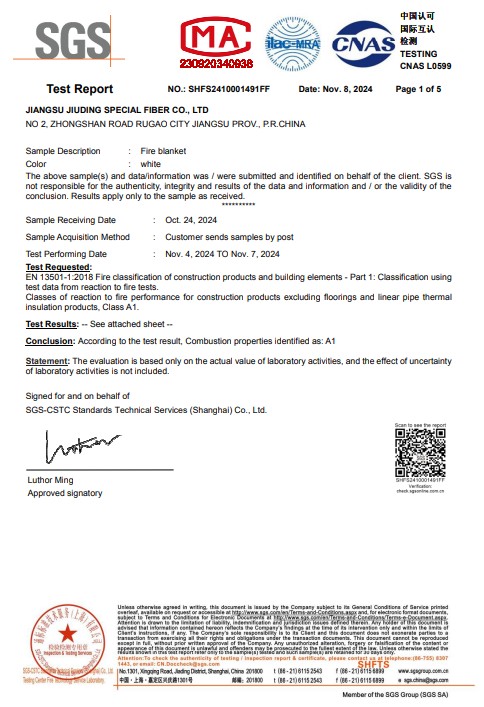High Silica Car Fire Blanket Introduction
High silica car fire blanket fiberglass cloth is a high-temperature resistant, soft inorganic fiber with more than 96% SiO2 content. It withstands heat and can be used continuously in 1000℃ environments, with an instantaneous heat resistance up to 1400℃ and a softening point near 1700℃.
It has stable chemical properties, resists acids, alkalis, and ablation, and has high strength. This makes it suitable for high-temperature insulation in fire protection, electric welding, aerospace, smelting, and other fields.
Working Principle
1. Cover the Fire Source: When a fire occurs, quickly place the fire blanket over the fire source.
2. Isolate Oxygen: The fire blanket cuts off the fire’s contact with air, reducing the oxygen supply and gradually extinguishing the flames.
3. Heat Isolation: High-silicon-oxygen materials effectively isolate high temperatures, prevent heat spread, and protect the surrounding environment and personnel.
Advantages of a High Silica Car Fire Blanket
1. Easy to Operate: Simple to use, suitable for everyone.
2. Efficient Fire Extinguishing: Quickly extinguishes fires and prevents spreading.
3. Non-toxic and Harmless: Made from non-toxic materials that do not release harmful gases.
4. Portable Storage: Compact design for easy storage and carrying.
Why can a battery start to burn?
Lithium-ion batteries are used in many battery-operated devices. Lithium is very reactive and highly flammable. Even a simple overheating of the battery can be enough to trigger a chain reaction leading to self-destruction (thermal runaway). The reaction causes the temperature inside the cell to rise, causing the electrolyte to evaporate and the pressure inside the cell to rise. The excess pressure causes the cell to burst and battery gases to be released. When these flammable gases escape, flash flames can form. Even without flames, enough heat is released to exceed the critical temperature for thermal runaway in neighboring cells. The resulting fire is difficult to control and can hardly be managed using conventional extinguishing methods.
Reasons for a battery defect:
- Mechanical overload
- Warming from outside
- Overheating while charging
- Deep discharge
- Moisture penetration
- Overload
- Production defect
- Chemical aging
How is a battery fire extinguished and how is the fire blanket used?
The term "extinguishing" in connection with a lithium-ion battery fire is incorrect. Lithium-ion battery fires cannot be extinguished by depriving them of oxygen, as they will always ignite themselves.
High silica fiberglass fire containment blanket can help here. It was specially developed for the prevention and fighting of fires involving lithium-ion batteries. The blanket isolates the fire and prevents the flames from spreading to the surrounding area. Thanks to its open-pored material, it prevents ballooning caused by gases and absorbs extinguishing water - an important property. The burning object is cooled and less extinguishing water is required. This leads to less contamination of the site and provides thermal shielding of the surrounding area by absorbing the extinguishing water.
In everyday use, we often talk about a fire blanket. The term fire blanket is incorrect in the context of an electric car fire. Fires in lithium-ion batteries cannot be extinguished by depriving them of oxygen, as they repeatedly ignite themselves. The fire containment ceiling serves to protect against heat and the environment.
It is easy to use. When smoke develops, it is pulled over the object using loops and the fire is encapsulated. To cool the burning object, extinguishing water is sprayed onto the blanket. The material is designed to absorb extinguishing water and at the same time create a cooling effect, which makes it possible to fight the fire more effectively and provides thermal shielding.
Certificates
DIN SPEC 91489--
EN13501-1--A1
We recommend: The fire blanket should only be used by emergency services or specially trained personnel.
FAQ - Frequently Asked Questions
What temperatures can the fire blanket withstand?
A battery fire can cause temperatures of up to 1000-1100 °C. High silica fire blanket is temperature-resistant up to 1050-1150 °C and short-term up to 1300-1450 °C. However, the aid of a fire hose will increase the surface temperature and working time of the blanket.
How many people are needed to use the fire blanket?
The fire blanket weighs around 28 kg in the standard format 8×6 meters. It can be easily pushed to the site of use in the rolling trolley. Two people are required to pull the blanket over the burning vehicle. The fire blanket is designed in such a way that it can be wrapped in less than 20 seconds. For smaller formats, such as for use in workshops, one person is sufficient.
Can the fire blanket be used multiple times?
Short Answer:
Yes, but with conditions. Most fire blankets are designed for single-use in emergency scenarios, but some heavy-duty models (made of high-quality materials like fiberglass or silica) can be reused if undamaged and properly inspected after each use.
Factors Affecting Reusability
1. Material Type
2. Fire Type & Exposure
Single-use: Effective for small fires (e.g., cooking oil, electrical) but may degrade after smothering.
Reusable: Only if exposed to low-intensity fires and cleaned properly (e.g., no holes, burns, or chemical residue).
3. Damage Inspection
After use, check for:
Holes or tears → Discard immediately.
Charring or stiffening → Indicates fiber damage (unsafe for reuse).
Chemical contamination (e.g., oil, solvents) → May reduce effectiveness.
When to Replace a Fire Blanket?/ What is the shelf life of High Silica Fire Blanket ?
After extinguishing any fire (unless labeled reusable and professionally inspected).
Visible damage (e.g., discoloration, brittleness).
Expiration date (typically 5–7 years for unused blankets).
Best Practices for Reusable Fire Blankets
Clean gently with water and mild soap (no harsh chemicals).
Air-dry completely before folding/storing.
Store properly in a quick-access, dry location.
Key Takeaway
Household/standard blankets: Treat as single-use for safety.
Industrial-grade blankets (e.g., silica): May be reused if undamaged.
When in doubt, replace it—fire blankets are inexpensive compared to safety risks.
For critical environments (e.g., labs, factories), consult the manufacturer’s guidelines.
Are individual dimensions possible?
Individual workplaces require individual requirements.
Through our own development department as well as prototype and sample construction, we can pursue customer-specific requirements.
Get in touch with us!
How do we deploy the blanket in a tight area?
Each deployment of the EV fire blanket is going to require a unique approach. No two EV fires are the same. It's going to take training and best practices to figure out different scenarios of deployment depending on your application.
What is the required maintenance for the blanket?
The blanket is best kept in a dry place away from direct sunlight. It should be inspected every three2 years for creases and damage to the fibers.
What happens post fire?
The battery should stay contained within the blanket and monitored with a thermal imaging camera until the temperatures have reached a safe point.
Wholesale Distribution
Partner with JIUDING and access a global network
of Emergency Response & Fire Safety professionals.











